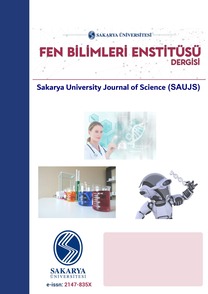Optimal energy production in the Yeşilırmak River Basin
___
M. Opan, “Multiobjective optimal operation in multiple reservoir systems,” Ph.D., Thesis, Kocaeli University, 2007.A. M. M .Maas, R. Hufschmidt, H. A. Dorfman , Jr. S. A. Thomas, G. M. Fair. Marglin, “Design of water resources systems,” Harvard University Press, Cambridge, MA, 1962.
A. Kangrang and C. Lokham, “Optimal reservoir rule curves considering conditional ant colony optimization with simulation model,” Journal of Applied Sciences, vol.13, no.1, pp. 263-267, 2013.
J.W. Labadie, “Optimal operation of multireservoir systems: State-Of-The-Art,” Journal of Water Resources Planning and Management, vol. 130, no. 2, pp. 93-111, 2004.
W. Yeh, “Reservoir management and optimization models: A state of the art Review,” Water Resources Research, vol. 21, no. 12, pp. 1797–1818, 1985.
D.P. Loucks and E.V. Beek, “Water resources system planning and managemen,” Paris, United Nations Educational, Scientific and Cultural Organization, 2005.
D. Rani and M.M. Moreira, “Simulationoptimization modeling: A survey and potential application in reservoir,” Water Resources Management, no. 24, pp. 1107- 1138, 2010.
R. Bellman, “Dynamic programming,” Princeton University Pres, Princeton, N.J., 1957.
R. Bellman and S. Dreyfus, “Applied dynamic programming,” Princeton University Pres, Princeton, N.J., 1962.
P. Nopmongcol and A. Askew, “Multi-level incremental dynamic programming,” Water Resources Research, vol. 12, no. 6, pp. 1291-1297, 1997.
A. Ahmad, A. El-Shafie, S. F. M. Razali, Z.S. Mohamad, “Reservoir optimization in water resources: A review,” Water Resources Management, vol. 28, pp. 3391- 3405, 2014.
S.J Yakowitz. “Dynamic programming applications in water resources,” Water Resources Research, vol. 18, no. 4, pp. 673–696, 1982.
G. Young, “Finding reservoir operating rules,” ASCE-Journal of Hydraulics Division, vol.93, no.6, pp. 297-321, 1967.
R. Larson, “State increment dynamic programming,” Elsevier, New York, 1968. [15] W. Hall, R. Harboe, W. Yeh and A. Askew, “ Optimum firm power output from a two reservoir system by incremental dynamic programming, ” Water Research Center, University of California, Los Angeles, 1969.
M. Hiedari, V. Chow, P. Kotovic and D. Meredith, “ Discrete differencial dynamic programming approach to water resources system optimization, ” Water Resources Research, vol. 7, no. 2, pp. 2733-282, 1971.
M. Sert, “System optimization in water resources planning,” TUBITAK Marmara Scientific and Industrial Research Institute, Operations Research Department, Press, Kocaeli, Turkey, 1987.
J. Giles and W. Wunderlich, “Weekly multipurpose planning model for TVA reservoir system,” Journal of Water Resources Planning and Management, vol. 107 no. 2, pp. 495-511, 1981.
M. Sert, M. Öcal, N. Oktay and M. Ertuğrul, “Sakarya Basin optimal energy production project,” TUBITAK Marmara Scientific and Industrial Research Institute, Operations Research Department, Kocaeli, Turkey, 1983.
J. Yi, J. Labadie and S. Stitt, “Dynamic optimal unit commitment and loading in hydropower systems,” Journal of Water Resources Planning and Management, vol. 129, no. 5, pp. 388-398, 2003.
J.H. Yoo, “Maximization of hydropower generation through the application of a linear programming model,” Journal of Hydrology, vol. 376, no. 1, pp. 182–187, 2009.
V. Jothiprakash and R. Arunkumar, “Multireservoir optimization for hydropower production using NLP technique,” KSCEJournal of Civil Engineering, vol. 18, no. 1, pp. 344-354, 2014.
C. Li, J. Zhou, S. Ouyang, X. Ding and L. Chen, “Improved decomposition– coordination and discrete differential dynamic programming for optimization of larges hydropower system,” Energy Conversion and Management, no. 84, pp. 363-373, 2014.
P.Liu, S. Guo, X. Xu, and J. Chen, “Derivation of aggregation-based joint operating rule curves for Cascade hydropower reservoirs, ” Water Resources Management, vol. 25, pp. 3177-3200, 2011.
R.S.V. Teegavarapu and S.P. Simonovic, “Simulation of multiple hydropower reservoir operations using system dynamics, Water Resources Management, no. 28, pp. 1937-1958, 2014.
General Directorate of State Hydraulic Works (DSİ), 2015.
J. S. Anagnostopoulos and D. E. Papantonis, “Optimal sizing of a run-ofriver small hydropower plant,” Energy Conversion and Management, vol. 48 no.10, pp. 2663–2670, 2007.
D. De Ladurantaye, M. Gendreau and, J.Y. Potvin, “Optimizing profits from hydroelectricity production,” Computers & Operations Research., vol. 36, pp. 499-529, 2009.
W. Huang, C. Murray, N. Kraus, and J. Rosati, “Development of a regional neural retwork for coastal water level predictions,” Ocean Engineering, vol.30, no.17, pp. 2275–2295, 2003.
O. Haddad, M. Moradi-Jalal, and M. A. Mariño, “ Design–operation optimisation of run-of-river power plants,” Proceedings of the Institution of Civil Engineers-Water Management, vol. 164, no.9, pp. 463–475, 2011.
- ISSN: 1301-4048
- Yayın Aralığı: 6
- Başlangıç: 1997
- Yayıncı: Sakarya Üniversitesi Fen Bilimleri Enstitüsü
NONLINEAR FINITE ELEMENT ANALYSIS OF INTERVERTEBRAL DISC: A COMPARATIVE STUDY
Improving physical properties of plant growing media using perlite
EMRAH BUDAKOĞLU, GÜNDÜZ HORASAN, Hilal YALÇIN, LEVENT GÜLEN
Optimization of four different mineral additive combinations to reduce alkali silica reaction
KORKMAZ YILDIRIM, MENSUR SÜMER
Optimal energy production in the Yeşilırmak River Basin
Fracture surface investigations of API pipes welded with parameters determined by Taguchi method
Elif AŞIKUZUN, Cemil ÇETİNKAYA, Mustafa BOZ, Hakan ADA
Determination of Solubility Characteristic of (Bi, Gd) Substitution in Bi-2223 Inorganic Compounds
Seasonality of Precipitation in Turkey: Past, Present and Future Assessments
